Summary During the month of August, 2012, the Mara veterinary unit was involved in a number of activities including treatment of two elephants in Naboisho conservancy
Summary During the month of August, 2012, the Mara veterinary unit was involved in a number of activities including treatment of two elephants in Naboisho conservancy. The unit also conducted an active surveillance and epidemiological survey of malignant catarrhal fever (MCF) disease in wildebeest of Masai Mara ecosystem, this was a collaborative effort between KWS, DSWT and University of Nairobi. All the veterinary activities went on successfully during the month as reported below.
Treatment of a wounded male elephant in Naboisho Conservancy, Masai Mara.
This was a case of an adult male elephant which had a penetrative wound on the left lateral side of the abdomen in Naibosho conservancy within the Mara ecosystem. The wound was already infected with a lot of necrotic debris and pus oozing out from openings. Similarly there was another wound on the right thigh which was beginning to heal but still had pus accumulations and swollen. The elephant was extremely weak and unable to move mostly preferring to remain standing under shrubs all day without any movement. The cause of the injury was not known but it was suspected that the animal could have been shot by an arrow-head while being chased out of the homesteads around that place or attempted poaching. The elephant was sighted by the scouts and manager of Naibosho conservancy who immediately informed the vet to attend to it. It was under a great pain and moved with a lot of difficulties.
Chemical immobilization, examination and treatment
The elephant was darted from a vehicle using 18mgs of etorphine Hcl combined with 3000 i.u on the left thigh. The drug took effect after about 7 minutes and it became recumbent. The two wounds were then examined for the presence of any foreign material but there was none, all the accumulated pus and necrotic tissue debris were pressed out completely relieving the elephant from abdominal pressure resulting from the fluid and pus accumulation. The wounds were also cleaned and debrided using 10% hydrogen peroxide draining all the accumulated pus and necrotic tissue debris, then treated using a topical application of a tincture of iodine and oxytetracycline spray. It was also covered with green clay powder which maintains wound cleanliness, repel flies and enhance pus drainage. Further treatments by intramuscular administration of long-acting Amoxycillin (Betamox) antibiotics and flunixin meglumine were also provided.

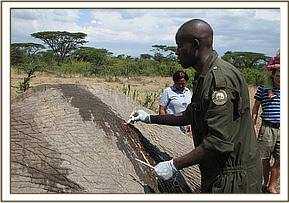
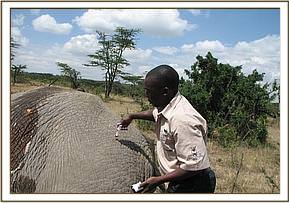

Revival of anaesthesia
After treatment, the elephant was revived from anaesthesia using 48mgs of diprenorphine hydrochloride administered through the superficial ear-vein. It was to be monitored closely by the scouts and management of Naibosho conservancy who would report the progress to the vet in case the elephant required further treatment. However, the prognosis was not good due to suspected poisonous effect of the weapon that caused the injuries.
Investigation of Malignant catarrhal fever (MCF) in wildebeests of Masai Mara
Bovine malignant catarrhal fever (MCF) is an acute viral disease affecting cattle in both developed and developing countries, posing a serious threat to animal productivity and food security. Wildebeests are the key reservoirs of the disease which currently has no cure or vaccine, treatment is only supportive. In Kenya, MCF was first documented in 1960 (Plowright et al). The classical symptoms of the disease are high fever, mouth ulcers, poor feeding, weakness, eye/nose discharge, conjunctivitis and blindness. MCF causes catastrophic losses to livestock farmers as 90 - 100% mortality occurs in affected cattle herds.
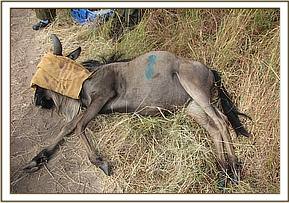
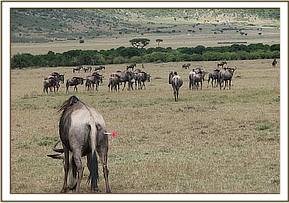


Thirty (30) wildebeests were captured by darting from a vehicle using 3 - 5mgs of etorphine hydrochloride combined with 30mgs of xylazine hydrochloride depending on age and size. Blood and tissue samples were collected from each animal and will be analyzed for MCF disease.
Treatment of a wounded male elephant near Porini Camp in Naboisho Conservancy, Masai Mara.
This was also a case of an adult male elephant which had a severe extensive wound on the right lateral side of the abdomen a few kilometers away from Porini camp in Naboisho conservancy. The wound was already much infected with a lot of necrotic debris and pus oozing out from openings. The cause of the injury was not established but it was an arrow wound and most probably a poisoned arrow. The animal was quite weak and very much emaciated and unable to walk and feed freely. It preferred to remain standing under trees and shrubs most of the day. The elephant was sighted by the scouts and manager of Naboisho conservancy who immediately informed the vet to attend to it. It also had the risk of developing peritonitis and septiceamia that could easily lead to death.
Chemical immobilization, examination and treatment
The elephant was located in a thick shrub along the river and darted from the ground using 17mgs of etorphine Hcl combined with 1500 i.u on the left thigh. The drug took effect after about 6 minutes and it became recumbent. The wound was then examined but had no foreign object. It was also probed using long tissue forceps in an attempt to find out how deep it penetrated into the tissues of the abdomen but it was only superficial about 1 inch deep. Then wound was then cleaned with a lot of water and gauze swabs removing all the mud, maggots and loose tissue debris. It was also cleaned and debrided using 10% hydrogen peroxide draining all the accumulated pus and necrotic tissue debris, then treated using a topical application of a tincture of iodine and oxytetracycline spray and covered with green clay powder which maintains wound cleanliness, repel flies and enhance pus drainage. Further treatments using long-acting antibiotics and antinflammatory drugs were provided by intramuscular injection.
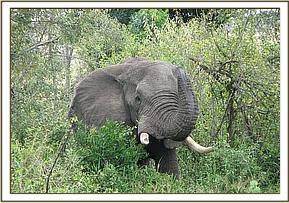
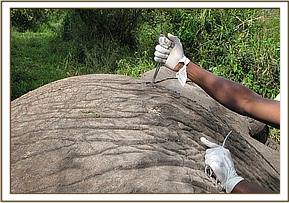

Revival of anaesthesia
After treatment, the elephant was revived from anaesthesia using 48mgs of diprenorphine hydrochloride administered through the superficial ear-vein. However, the prognosis was poor due to the effect of poisonous substance used to inflict the injury. It was to be monitored closely by the scouts and management of the conservancy who would report the progress to the vet in case the elephant required further treatment.
Conclusion We do acknowledge the support of the David Sheldrick Wildlife Trust towards provision of wildlife veterinary services in Masai Mara ecosystem this has significantly contributed to the general wildlife conservation in these areas. We also acknowledge the support of the rangers and staff from Masai Mara National Reserve, Naboisho wildlife conservancy and the surrounding community-owned wildlife conservancies for continuous support and reporting of wildlife incidences requiring veterinary intervention in the Mara ecosystem.
Report by: Dr. Domnic Mijele